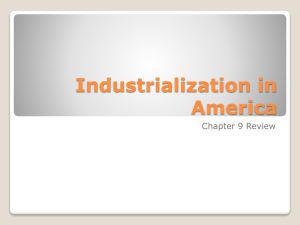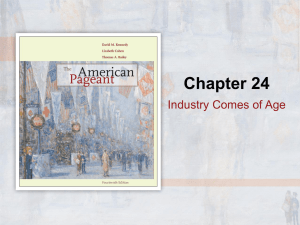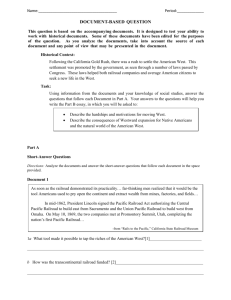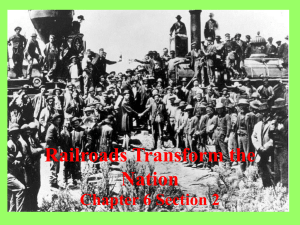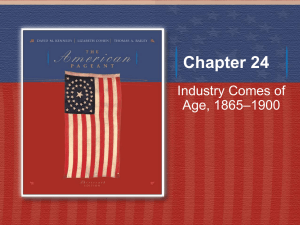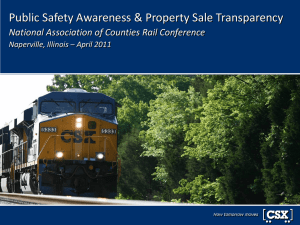Railroads - Pittsfield Public Schools
advertisement
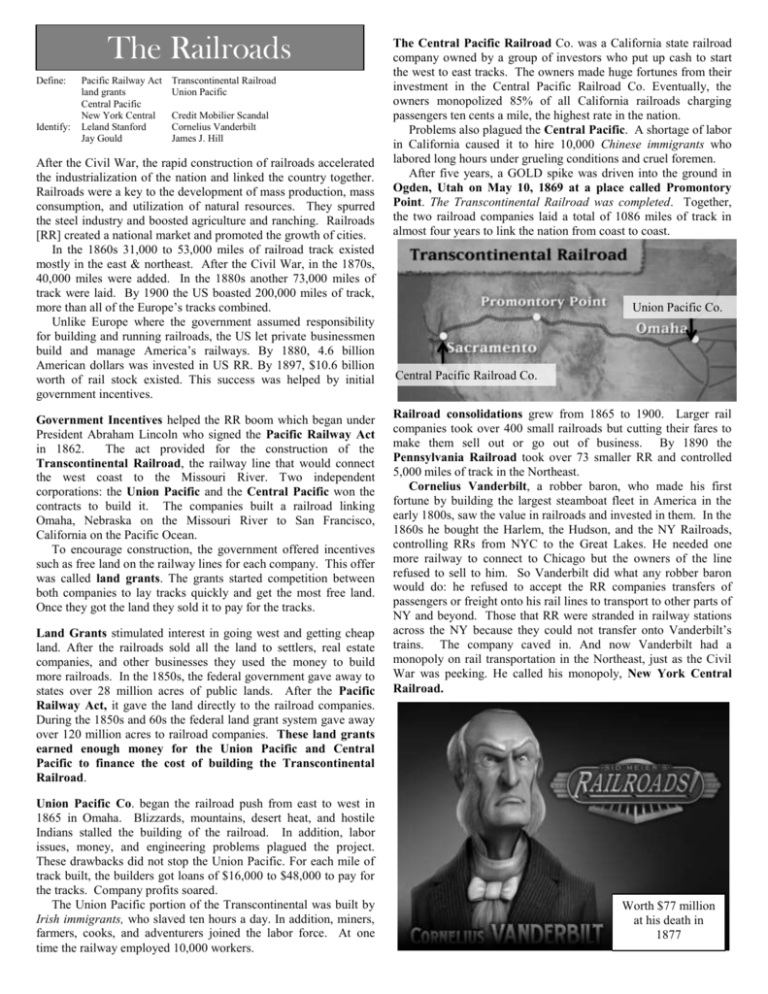
The Railroads Define: Identify: Pacific Railway Act land grants Central Pacific New York Central Leland Stanford Jay Gould Transcontinental Railroad Union Pacific Credit Mobilier Scandal Cornelius Vanderbilt James J. Hill After the Civil War, the rapid construction of railroads accelerated the industrialization of the nation and linked the country together. Railroads were a key to the development of mass production, mass consumption, and utilization of natural resources. They spurred the steel industry and boosted agriculture and ranching. Railroads [RR] created a national market and promoted the growth of cities. In the 1860s 31,000 to 53,000 miles of railroad track existed mostly in the east & northeast. After the Civil War, in the 1870s, 40,000 miles were added. In the 1880s another 73,000 miles of track were laid. By 1900 the US boasted 200,000 miles of track, more than all of the Europe’s tracks combined. Unlike Europe where the government assumed responsibility for building and running railroads, the US let private businessmen build and manage America’s railways. By 1880, 4.6 billion American dollars was invested in US RR. By 1897, $10.6 billion worth of rail stock existed. This success was helped by initial government incentives. Government Incentives helped the RR boom which began under President Abraham Lincoln who signed the Pacific Railway Act in 1862. The act provided for the construction of the Transcontinental Railroad, the railway line that would connect the west coast to the Missouri River. Two independent corporations: the Union Pacific and the Central Pacific won the contracts to build it. The companies built a railroad linking Omaha, Nebraska on the Missouri River to San Francisco, California on the Pacific Ocean. To encourage construction, the government offered incentives such as free land on the railway lines for each company. This offer was called land grants. The grants started competition between both companies to lay tracks quickly and get the most free land. Once they got the land they sold it to pay for the tracks. Land Grants stimulated interest in going west and getting cheap land. After the railroads sold all the land to settlers, real estate companies, and other businesses they used the money to build more railroads. In the 1850s, the federal government gave away to states over 28 million acres of public lands. After the Pacific Railway Act, it gave the land directly to the railroad companies. During the 1850s and 60s the federal land grant system gave away over 120 million acres to railroad companies. These land grants earned enough money for the Union Pacific and Central Pacific to finance the cost of building the Transcontinental Railroad. Union Pacific Co. began the railroad push from east to west in 1865 in Omaha. Blizzards, mountains, desert heat, and hostile Indians stalled the building of the railroad. In addition, labor issues, money, and engineering problems plagued the project. These drawbacks did not stop the Union Pacific. For each mile of track built, the builders got loans of $16,000 to $48,000 to pay for the tracks. Company profits soared. The Union Pacific portion of the Transcontinental was built by Irish immigrants, who slaved ten hours a day. In addition, miners, farmers, cooks, and adventurers joined the labor force. At one time the railway employed 10,000 workers. The Central Pacific Railroad Co. was a California state railroad company owned by a group of investors who put up cash to start the west to east tracks. The owners made huge fortunes from their investment in the Central Pacific Railroad Co. Eventually, the owners monopolized 85% of all California railroads charging passengers ten cents a mile, the highest rate in the nation. Problems also plagued the Central Pacific. A shortage of labor in California caused it to hire 10,000 Chinese immigrants who labored long hours under grueling conditions and cruel foremen. After five years, a GOLD spike was driven into the ground in Ogden, Utah on May 10, 1869 at a place called Promontory Point. The Transcontinental Railroad was completed. Together, the two railroad companies laid a total of 1086 miles of track in almost four years to link the nation from coast to coast. Union Pacific Co. Central Pacific Railroad Co. Co. Railroad consolidations grew from 1865 to 1900. Larger rail companies took over 400 small railroads but cutting their fares to make them sell out or go out of business. By 1890 the Pennsylvania Railroad took over 73 smaller RR and controlled 5,000 miles of track in the Northeast. Cornelius Vanderbilt, a robber baron, who made his first fortune by building the largest steamboat fleet in America in the early 1800s, saw the value in railroads and invested in them. In the 1860s he bought the Harlem, the Hudson, and the NY Railroads, controlling RRs from NYC to the Great Lakes. He needed one more railway to connect to Chicago but the owners of the line refused to sell to him. So Vanderbilt did what any robber baron would do: he refused to accept the RR companies transfers of passengers or freight onto his rail lines to transport to other parts of NY and beyond. Those that RR were stranded in railway stations across the NY because they could not transfer onto Vanderbilt’s trains. The company caved in. And now Vanderbilt had a monopoly on rail transportation in the Northeast, just as the Civil War was peeking. He called his monopoly, New York Central Railroad. Worth $77 million at his death in 1877 The Robber Barons accumulated great wealth in owning railroads in the late 1800s. This led to accusations of corruption. Robber Barons were accused of: ripping off investors and taxpayers; bribing government men; cheating; and nonpayment of bills. One railroad robber baron with the worst reputation was Jay Gould. He used information he learned as a railroad owner to fix stock prices to his benefit. He even printed up worthless stock certificates for his Erie Railroad and sold them to Vanderbilt in 1868, thus taking the millions from Vanderbilt who ended up with worthless stock certificates. Later, he paid political officials and judges to look the other way when Vanderbilt sued him for fraud. After his loss, Vanderbilt said of Gould, “This Erie war has taught me that it never pays to kick a skunk!” By 1882 Gould personally owned 16,000 miles of track and controlled Western Union telegraph and AT&T, key communication services along his rail lines. He died leaving an estate worth $75 million. Extensive corruption plagued the railroad industry. In 1872 in the Credit Mobilier Scandal rocked the government. Credit Mobilier was a construction company, started in 1867 to build the Union Pacific Railroad. Its purpose was to take profits from building contracts but not to build a profitable railroad. They hired themselves and paid themselves to build the railroad at a cost of $50,000 per mile. But it cost the Union Pacific only $30,000 per mile to build it. Credit Mobilier overcharged the Union Pacific [itself] for the work, and paid themselves from the inflated bills. In one year the Credit paid 348% in profits to themselves. Congressmen were given stock in the corporation earned a tidy profit to look the other way. Judges were paid off to block investigations of the company. By the time the Union Pacific RR was completed, these investors made millions. But the railroad company used up all its federal grants and was nearly bankrupt. Scandal erupted. The investigation targeted members of Congress including the Vice-President and James Garfield (who later was 20th president of the US). In the end the Credit Mobilier Construction Company made a $73 million profit on $50 million worth of work and got away with bilking the government. The Great Northern Railroad owner was not like all railroad entrepreneurs who were robber barons. James J. Hill built and operated the Great Northern Railroad from St. Paul, Minnesota to Everett, Washington without federal land grants or subsidies. He planned the route carefully to pass by towns and traverse good land. He offered low fares to settlers who homesteaded along his route. He successfully identified products needed in China such as cotton, textiles, and flour. He then arranged to haul these goods to Washington for shipment to Asia. The railroad earned money by hauling goods both east and west instead of hauling lumber and farm goods east and returning empty to the west. Operating without government grants, the Great Northern became the most successful transcontinental railroad and the only one not forced into bankruptcy by the turn of the century. Questions: 1. Between 1860 and 1900 how many more miles of tracks were laid in the US? 2. What incentives did the government provide to companies who agreed to build the Transcontinental Railroad? How important were these incentives to the railroad companies? 3. How long did it take to build the Transcontinental RR? What were the problems The Union Pacific ran into? What problems did the Central pacific run into? 4. What immigrants built the Transcontinental Railroad? Which immigrants worked for The Union Pacific? The Central Pacific? 5. What was the Pennsylvania railroad? 6. How did Vanderbilt gain his railroad monopoly? Describe. 7. How did Jay Gould swindle Vanderbilt? How did he get away with it? 8. Who was involved in the Credit Mobilier scandal? How much profit did the company make in the end? 9. How was James Hill different from the other railroad tycoons? What is the proof of its success? 10. In the political cartoon of Jay Gould above what is he portrayed as? Who do suppose the bowling pins are?
